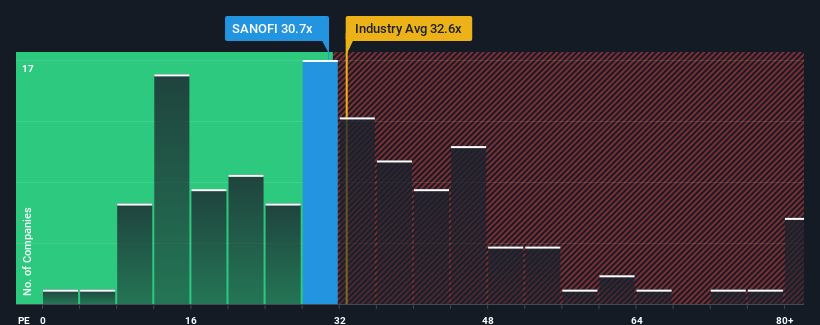Risks To Shareholder Returns Are Elevated At These Prices For Sanofi India Limited (NSE:SANOFI)

It's not a stretch to say that Sanofi India Limited's (NSE:SANOFI) price-to-earnings (or "P/E") ratio of 30.7x right now seems quite "middle-of-the-road" compared to the market in India, where the median P/E ratio is around 29x. Although, it's not wise to simply ignore the P/E without explanation as investors may be disregarding a distinct opportunity or a costly mistake.
Sanofi India could be doing better as it's been growing earnings less than most other companies lately. One possibility is that the P/E is moderate because investors think this lacklustre earnings performance will turn around. You'd really hope so, otherwise you're paying a relatively elevated price for a company with this sort of growth profile.
Check out our latest analysis for Sanofi India

Is There Some Growth For Sanofi India?
The only time you'd be comfortable seeing a P/E like Sanofi India's is when the company's growth is tracking the market closely.
Taking a look back first, we see that the company managed to grow earnings per share by a handy 2.8% last year. Pleasingly, EPS has also lifted 32% in aggregate from three years ago, partly thanks to the last 12 months of growth. Accordingly, shareholders would have probably welcomed those medium-term rates of earnings growth.
Shifting to the future, estimates from the four analysts covering the company suggest earnings should grow by 7.9% over the next year. With the market predicted to deliver 26% growth , the company is positioned for a weaker earnings result.
In light of this, it's curious that Sanofi India's P/E sits in line with the majority of other companies. It seems most investors are ignoring the fairly limited growth expectations and are willing to pay up for exposure to the stock. These shareholders may be setting themselves up for future disappointment if the P/E falls to levels more in line with the growth outlook.
The Key Takeaway
We'd say the price-to-earnings ratio's power isn't primarily as a valuation instrument but rather to gauge current investor sentiment and future expectations.
We've established that Sanofi India currently trades on a higher than expected P/E since its forecast growth is lower than the wider market. When we see a weak earnings outlook with slower than market growth, we suspect the share price is at risk of declining, sending the moderate P/E lower. This places shareholders' investments at risk and potential investors in danger of paying an unnecessary premium.
Having said that, be aware Sanofi India is showing 1 warning sign in our investment analysis, you should know about.
If you're unsure about the strength of Sanofi India's business, why not explore our interactive list of stocks with solid business fundamentals for some other companies you may have missed.
New: Manage All Your Stock Portfolios in One Place
We've created the ultimate portfolio companion for stock investors, and it's free.
• Connect an unlimited number of Portfolios and see your total in one currency
• Be alerted to new Warning Signs or Risks via email or mobile
• Track the Fair Value of your stocks
Have feedback on this article? Concerned about the content? Get in touch with us directly. Alternatively, email editorial-team (at) simplywallst.com.
This article by Simply Wall St is general in nature. We provide commentary based on historical data and analyst forecasts only using an unbiased methodology and our articles are not intended to be financial advice. It does not constitute a recommendation to buy or sell any stock, and does not take account of your objectives, or your financial situation. We aim to bring you long-term focused analysis driven by fundamental data. Note that our analysis may not factor in the latest price-sensitive company announcements or qualitative material. Simply Wall St has no position in any stocks mentioned.
About NSEI:SANOFI
Sanofi India
Manufactures and trades in drugs and pharmaceutical products in India, Singapore and internationally.
Excellent balance sheet average dividend payer.
Similar Companies
Market Insights
Community Narratives




